UK Online Shopping Trends: Student Insights
Chapter 1. Introduction
Introduction
This study focuses on satisfaction level toward online shopping among students of London Study Group. Nowadays everyone has started moving away from traditional shopping to online shopping. One of the online shops targeted market is the students. E-commerce growth in the UK for 2015 is 16.2% and predicted at 2016 will be 14.9% (Gemma, 2016). Total value for online transactions in the UK for 2015 is €157 Billion (Ecommerce, 2016). Looking at the transaction value that most people are having online shopping so much and still need to find out for how satisfy are people in online shopping. Some of the reasons on why consumers have opted online shopping are convenient, lower price, variety, fewer expenses, comparison of prices, crowds, compulsive shopping, discreet purchases (Miller, 2012).
Research Background
In current market, online shopping has developed so fast and some companies have improved their sales significantly after selling online. Consumers are experiencing benefits from online shopping but in some cases, there are problems which lead customers to dissatisfaction. The reasons are mentioned in the questionnaire that will analyse from respondents of the research. In this study, I have taken a group of students from a London College to find out their level of satisfaction on their online shopping experience and what attracts them to opt for online shopping.
Aim of the Study
To find out the level of satisfaction and factors attracting to shop online among London Study Group Students.
Objectives of the Study
To analyse the level of satisfaction on online shopping of students of study group London.
To identify the factors attracting students of study group London to do online shopping.
Research Questions
What is the study group satisfaction level on their online shopping experience?
What are the factors that attract the study group who has opted for online shopping?
Chapter 2. Literature Review
Introduction
The growth of the world wide web provides consumers an easy access to look for information about products and services on the internet. The traditional marketing system which formerly used by retail shops, is nowadays changing to online system. Some companies have started opening virtual shops rather than having a physical shops, for example Amazon, Ebay, Alibaba etc. Online shoppers varies in age and backgrounds. This study examines the satisfaction level and factors attracting students to shop online in the United Kingdom. Online shopping is purchasing products or services over the internet, and customer satisfaction is a measure of how a product or services meets the consumers expectation.
Literature review
In 2016, 92.6% of the UK population are internet users and this number increased by 0.3% from 2015 (Internetlivestats, 2016). As a knock-on effect, smart phone sales increased. Both are correlated. SalesEurostat (2017) found that two third of internet users in EU shopped online in 2016. The highest proportions for shopping online were found in the 16-24 age groups (68%) and in 25-54 age groups (69 %). The first group (16 – 24 years) mostly consist of student, which students are the targeted market. To keep the sales growth, it is necessary to find out the factors that attract students to do online shopping. The biggest four online shopping markets in the world are the UK, the US, Germany and China. Chinese shoppers now purchase products online from British retailers almost as frequently as domestic shoppers do. British retailers are the most popular international brands for German shoppers, and the second most popular are the US and China (Ruddick, 2015). The world highest consumers spend in a year for online shopping is Hong Kong at $2868 per person per year (Clifford, 2015). Online spending correlates with the country wealth. The graph below shows the internet user who purchase online by age and employment category in EU at 2016 (Eurostat, 2017).
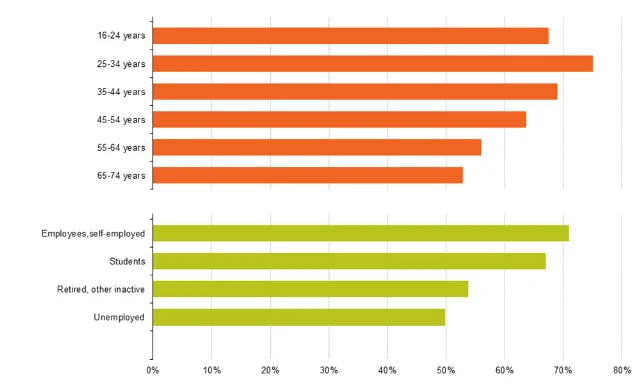

Research conducted by Goswami et al. (2013) over students at Jorhat India found that satisfaction for online shopping depends on variety and availability of products (100% respondent satisfied). Students are satisfied with the packaging of product, payment procedure, cost of delivery, quality and delivery time toward online shopping, but those factors are less important compared to the availability of products. Another piece of research undertake by Rudansky (2014) found that satisfaction factors among the online shopper in Gauteng, South Africa are convenience, and selections of products. Uzun & Poturak (2014) found that factors affecting consumers while shopping online were convenience and trust, are quoted as the most important variables. The next ones in importance were prices and quality of products. Those variables are the most essential ones for consumers when they decide to shop online. Rudansky (2014) found that satisfaction factor among Bosnian online shopper is convenience. Different factors were found by Trong et al (2014), who discovered that delivery and payment methods have high implications on online shopping in Vietnam. But the availability of delivery service in the country is not as good as what is available in London, and the payment system in developing countries is not totally secure. This literature review has shown that convenience while doing online shopping and delivery are the most important factors of customer satisfaction, for people age of 20 – 50 are the ones who frequently do online shopping.
Chapter 3. Research Methodology
Data Collection Method
The primary data are directly collected from the respondents after answering all questions In the questionnaires. Twenty nine questionnaires were distributed and successfully collected all of them. The respondents for the study are students of a London college which consist of Law students, International year 1 students, International foundation year 1 students and Pre-Master students. The data processed to statistical data. The data processed are analysed based on the answers gathered from the study group. The questions were designed in various types, such as open questions (7), close questions (9) and ranking questions (1). The last section is opinion and suggestion toward online shopping. The first 5 questions are relating with the respondent background. The secondary data for the research are taken from the website, journal, books, newspaper, and tabloid which relating with the customer satisfaction.
Data Analysis Method
Study for this research used a quantitative methodology because the main data processed based on number and statistical data.
Chapter 4. Research Analysis and finding
Introduction
There are 18 questions for the questionnaires which 6 are open questions relating to respondents, 10 are close questions about respondents experience with online shopping, 2 ranking questions listing the factors attracting respondents to do online shopping and level of satisfaction for some categories at online shopping. Total number for the participants are 29 where 100% of the questionnaires was returned by the participants.
Data analysis
Gender of participants

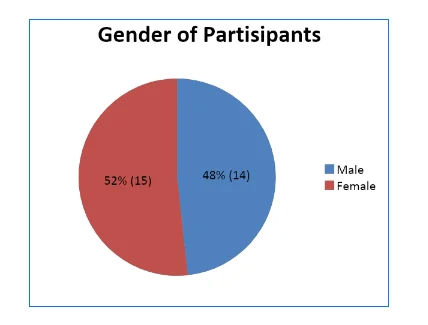
Figure 1, The questionnaires were distributed to 29 students and the requirement for this research are 25 respondents. There are 4 questionnaires exceeding the requirement to anticipate if any of respondents failed to return the questionnaires. The chart shows that 52% (15) of the respondents are women and 48% (14) are men.
Age group
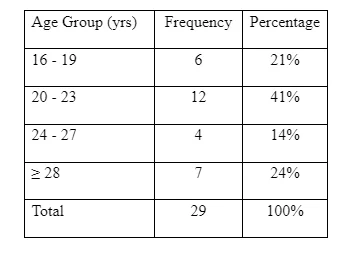
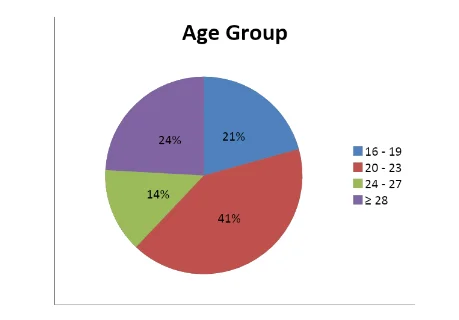
Figure 2, the respondents age group are classified in 3 years range in each age groups because students at the London college have similar age and to find out the response for each group more accurately. The respondents age group 16 – 19 are 21% (6), age group 20 – 23 are 41% (12), age group 24 – 27 are 14% (4) and age group 28 up are 24% (7).
Study program

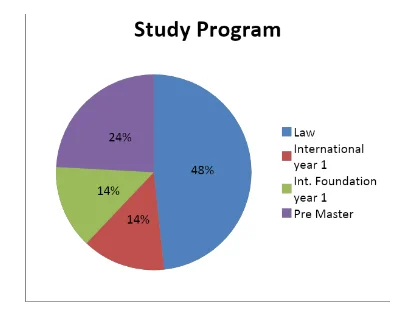
Figure 3, most of respondents are from Law Students 48% (14) which include LLM, LPC students, International Year One 14% (4), International Foundation Year One 14% (4), and Pre Master students 24% (7). Number of respondent are not equal for every program because some participants were on holiday and reading week.
Origin of the respondents
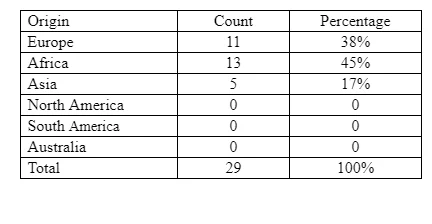

Figure 4, most of the respondents’ origin are from Africa 45% (13), Europe 38% (11) where some of them are Asian ethnic but has become Europe citizenship, Asia 17% (5). Respondents from North America, South America and Australia are not available.
Period of stay in London

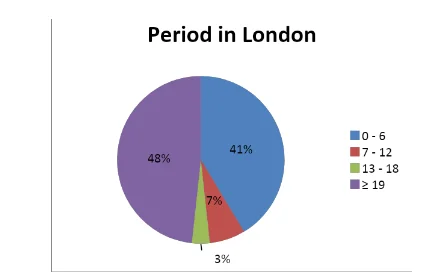
Figure 5, the respondents who have lived in London for 0 -6 months are 41% (12), for 7 – 12 months are 7% (2), for 13 – 18 months are 4% (1) and more than 19 months are 48% (14).
Factors attracting to do online shopping
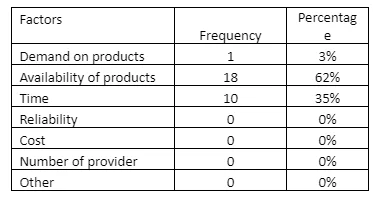

Figure 6, the factors that attracted respondents to do online shopping. Demand on products 3% (1), availability of product (62% (18), time 35% (10), reliability 0%, cost 0%, number of provider 0%, and other factor 0%. These factors are one of the objective for this research.
Satisfaction Level



Figure 7, Figure 8, Figure 9 are showing the level of satisfaction for website accessibility 93% (27), variety of products 97% (28), product availability 93% (27), time 86% (24), return policy 76% (22), security of transaction 97% (28), information privacy 83% (24), customer service 72% (21).
Mode of payment
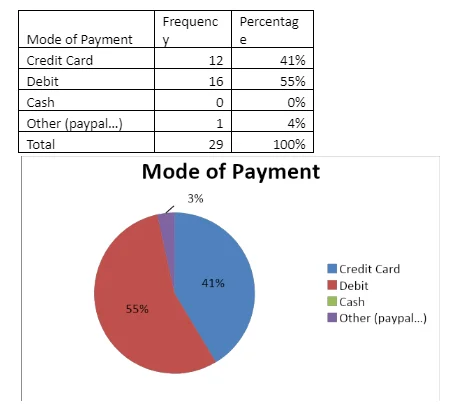
Figure 10, the respondents paid with credit card 41% (12), debit card 55% (16), cash 0% and other payments such as Paypal 4%.
Finding
The highest factor attracting respondents to do online shopping generally are availability of products 62%, time 35% and demand on products 3%. In this study, time means the period of time spent to purchase the products comparing to visiting the retail shop. The factor by gender, 60% of female attracted by availability of products and 33% attracted by time, 7% attracted by demand on products. The male respondents are attracted 64% by availability of products and 36% by time. The satisfaction level in general for the categories are 97% of are satisfied by the variety of products and security of transaction, 93% satisfied by website accessibility and products availability, 86% satisfied by products quality, 83% satisfied by delivery time and information privacy, 76% satisfied by return policy and 72% satisfied by the customer service.
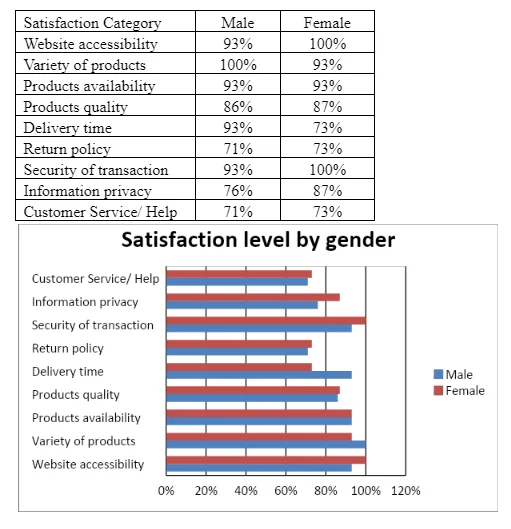
According to Figure 11, the female respondents are most satisfied by security of transaction and website accessibility (100%) followed by products availability and variety (93%), otherwise the male respondents are most satisfied by variety of products (100%) which followed by website accessibility, products availability, delivery time and security of transaction (93%).
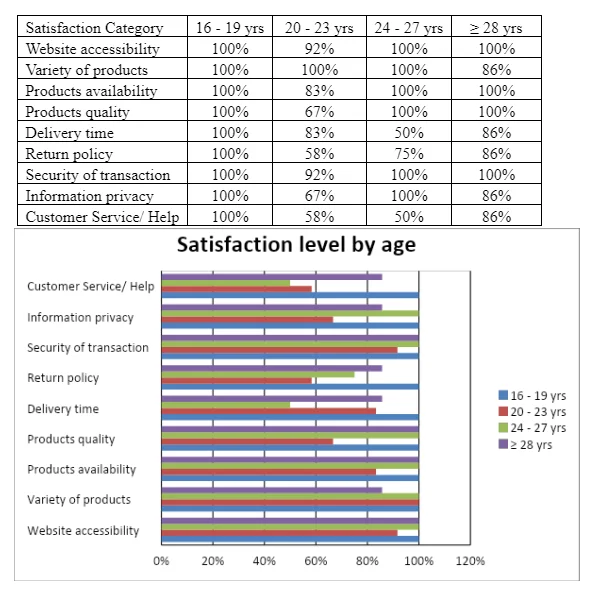
At Figure 12, the respondents of age 16 – 19 years are satisfied 100% for all the categories. The respondents of age 20 – 23 years are most satisfied by variety of products (100%). The respondent of age 24 – 27 years are most satisfied by website accessibility, variety of products, products availability, products quality, security transaction and information privacy (100%). The respondents of age 28 years up are most satisfied by website accessibility, products availability, products quality and security of transaction (100%). Each group of respondents have different category of satisfaction.
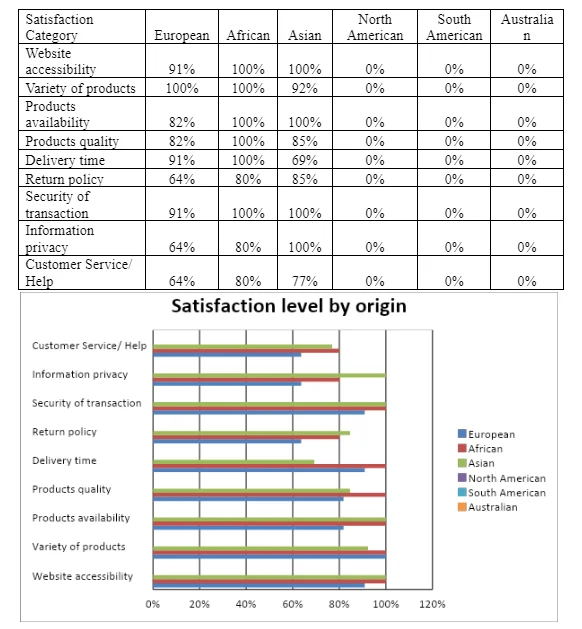
At Figure 13, the satisfaction level based on origin which respondents from Europe are most satisfied by the variety of the products (100%). Respondents from Africa are most satisfied by website accessibility, variety of products, products availability, products quality, delivery time and security of transaction (100%). Respondents from Asia are most satisfied by website accessibility, products availability, security of transaction and information privacy (100%). Obviously, the origin of the respondents affecting the category of satisfaction.

Chapter 5. Conclusion and recommendation
Conclusion
The aim of the study is to find out the satisfaction level of students while doing online shopping. Based on the outcome from questionnaires that respondents are satisfied toward online shopping, at Figure 9, all categories have satisfaction level above 72%, at Figures 11, the satisfaction level based on gender are above 71%, at Figure 12, satisfaction level based on age group are different that age 16 – 19 years satisfied 100% with all categories, age 20 – 23 years are neutral for return policy and customer service, age 24 – 27 years are neutral for delivery time and customer service and age 28 up has satisfaction level above 86%. At figure 13, satisfaction level for respondents from Europe is above 64%, respondents from Africa has Satisfaction level above 80% and respondents from Asia have satisfaction level above 69%. Overall, the respondents are satisfied toward online shopping. At Figures 6, The chart shows the main factor attract respondents to do online shopping, which availability of products (662%) is the main factor attracting respondent to do online shopping followed by time (35%).
Recommendations
Recommendation will be based on the outcome from the questionnaires:
The online shopping companies to provide discount price toward students.
Provide customer service on the phone because in case of any problem will not take another day to solve the problem.
Alert the students for any products relating to the students need.
- 24/7 Customer Support
- 100% Customer Satisfaction
- No Privacy Violation
- Quick Services
- Subject Experts



